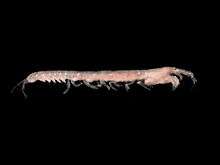Tanaidacea
| Tanaidacea | |
|---|---|
 | |
| Tanaissus lilljeborgi (a tanaid from the North Sea) | |
| Scientific classification | |
| Kingdom: | Animalia |
| Phylum: | Arthropoda |
| Subphylum: | Crustacea |
| Class: | Malacostraca |
| Superorder: | Peracarida |
| Order: | Tanaidacea Dana, 1849 |
| Suborders | |
| |
The crustacean order Tanaidacea (known as tanaids) make up a minor group within the class Malacostraca. There are about 940 species in this order.
Description
Tanaids are small, shrimp-like creatures ranging from 0.5 to 120 millimetres (0.020 to 4.7 in) in adult size, with most species being from 2 to 5 millimetres (0.08 to 0.2 in). Their carapace covers the first two segments of the thorax. There are three pairs of limbs on the thorax; a small pair of maxillipeds, a pair of large clawed gnathopods, and a pair of pereiopods adapted for burrowing into the mud. Unusually among crustaceans, the remaining six thoracic segments have no limbs at all, but each of the first five abdominal segments normally carry pleopods. The final segment is fused with the telson and carries a pair of uropods.[1]
The gills lie on the inner surface of the carapace. The thoracic limbs wash water towards the mouth, filtering out small particles of food with the mouthparts or maxillipeds. Some species actively hunt prey, either as their only food source, or in combination with filter feeding.[1]
Habitat
Most are marine, but some are also found in freshwater coastal habitat or estuaries. The majority of species are bottom-dwellers in shallow water environments, but a few live in very deep water, exceeding for some species 9,000 metres (30,000 ft). In some deep sea environment, they represent the most abundant and diverse fauna to be found.
Life cycle
Tanaids do not undergo a true planktonic stage. The early developmental period is spent while young are within the marsupium of the mother. Subsequently, post-larvae, called mancas, emerge as epibenthic forms. Some species are hermaphroditic.[1]
Taxonomy
The order Tanaidacea is divided into the following sub-orders, superfamilies and families:[2]
- Anthracocaridomorpha Sieg, 1980
- Anthracocarididae Schram, 1979
- Niveotanaidae Polz, 2005
- Apseudomorpha Sieg, 1980
- Apseudoidea Leach, 1814
- Apseudellidae Gutu, 1972
- Apseudidae Leach, 1814
- Gigantapseudidae Kudinova-Pasternak, 1978
- Kalliapseudidae Lang, 1956
- Metapseudidae Lang, 1970
- Numbakullidae Gutu & Heard, 2002
- Pagurapseudidae Lang, 1970
- Pagurapseudopsididae Gutu, 2002
- Parapseudidae Gutu, 1981
- Sphaeromapseudidae Larsen, 2011
- Sphyrapidae Gutu, 1980
- Tanzanapseudidae Bačescu, 1975
- Whiteleggiidae Gutu, 1972
- Cretitanaoidea Schram, Sieg, Malzahn, 1983
- Cretitanaidae Schram, Sieg, Malzahn, 1983
- Jurapseudoidea Schram, Sieg & Malzahn, 1986
- Jurapseudidae Schram, Sieg & Malzahn, 1986
- Neotanaidomorpha Sieg, 1980
- Neotanaidae Lang, 1956
- Tanaidomorpha Sieg, 1980
- Tanaoidea Dana, 1849
- Tanaidae Dana, 1849
- Paratanaoidea Lang, 1949
- Agathotanaidae Lang, 1971
- Anarthruridae Lang, 1971
- Colletteidae Larsen & Wilson, 2002
- Cryptocopidae (McLelland, 2008 MS) Bird & Larsen, 2009
- Leptochelidae Lang, 1973
- Leptognathiidae Lang, 1976
- Nototanaidae Sieg, 1976
- Mirandotanaidae Blazewicz-Paszkowycz & Bamber, 2009
- Paratanaidae Lang, 1949
- Pseudotanaidae Sieg, 1976
- Pseudozeuxidae Sieg, 1982
- Tanaellidae Larsen & Wilson, 2002
- Tanaissuidae Bird & Larsen, 2009
- Teleotanaidae Bamber, 2008
- Typhlotanaidae Sieg, 1986
- Tanaidomorpha incertae sedis
- Alavatanaidae Vonk & Schram, 2007
See also
References
- 1 2 3 Barnes, Robert D. (1982). Invertebrate Zoology. Philadelphia, PA: Holt-Saunders International. pp. 768–769. ISBN 0-03-056747-5.
- ↑ WoRMS (2011). "Tanaidacea". World Register of Marine Species. Retrieved July 29, 2011.
External links
![]() Data related to Tanaidacea at Wikispecies
Data related to Tanaidacea at Wikispecies